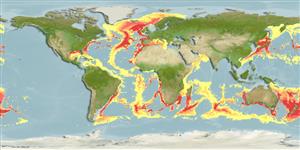Classificação / Names
Common names from other countries
Referência principal
Tamanho / Peso / Idade
Max length : 120 cm TL macho/indeterminado; (Ref. 6871); common length : 92.0 cm TL macho/indeterminado; (Ref. 247)
Length at first maturity
Lm 101.2, range 100 - ? cm
Ambiente
; marinhas batidemersal; intervalo de profundidade 150 - 3700 m (Ref. 55584), usually 400 - 2000 m (Ref. 35388)
Clima / Intervalo
Deep-water; 5°C - 13°C (Ref. 6871), preferred 20°C (Ref. 107945); 75°N - 61°S, 98°W - 147°E
Distribuição
Western Atlantic: Grand Banks to Delaware, USA; Cuba (Ref. 26340). Eastern Atlantic: Iceland south along Atlantic slope to the southwestern Cape coast of South Africa; also western Mediterranean. Western Pacific: off Japan, New Zealand, and Australia (Ref. 6871, 31367). Western Indian Ocean: Seychelles (Ref. 76802).
Países | Áreas FAO | Ecossistemas | Ocorrências | Introduções
Descrição breve
Espinhos dorsais (total): 2; Raios dorsais moles (total): 0; Espinhos anais 0; Raios anais moles: 0. Dorsal fins with very small spines, very short snout, lanceolate upper teeth and bladelike lower teeth with short, oblique cusps, stocky body that does not taper abruptly from pectoral region, very large lateral trunk denticles with smooth, circular, acuspidate crowns in adults and subadults (Ref. 247). Uniformly golden brown to dark brown in color (Ref. 6871).
Categoria na Lista Vermelha da IUCN (Ref. 115185)
Ameaça para o homem
Harmless
Utilização humana
Pescarias: pouco comercial
Mais informação
ReferênciasAquaculturaPerfil para aquaculturaEstirpesGenéticaFrequência dos alelosHereditariedadeDoençasProcessamentoMass conversion
ColaboradoresFotografiasStamps, CoinsSonsCiguateraVelocidadeTipo de nataçãoÁrea branquialOutras referênciasCérebrosVisão
Ferramentas
Relatórios especiais
Descarregue XML
Fontes da internet
Estimates of some properties based on models
Phylogenetic diversity index
PD50 = 0.5313 many relatives (e.g. carps) 0.5 - 2.0 few relatives (e.g. lungfishes)
Nível Trófico
4.5 ±0.1 se; Based on diet studies.
Resiliência
Muito baixo, tempo mínimo de duplicação da população maior que 14 anos (Fec=13-29)
Vulnerabilidade
Very high vulnerability (75 of 100)
Categoria de preço
